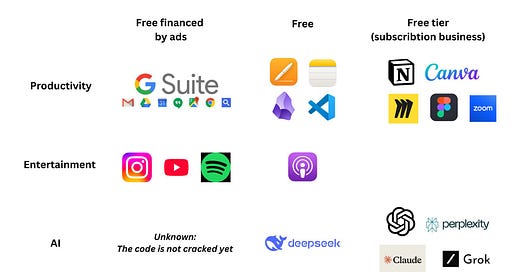Recently I heard some opinions regarding tech products for consumers:
Executives running companies that build tech for consumers: “It’s hard to get the credit card from the consumers to pay for the products. We need a bigger portfolio to increase the value”.
Investors: “We are not that interested in companies building tech for consumers. It’s too hard and the retention rate is low”.
Founder/engineer:” Most of the tech is provided by the American big tech companies for free. It’s very hard to charge the consumers”.
It got me to check what tech products I use as a consumer and what I have to pay for—surprisingly, not many. Below is what I use. What the last guy said is true. I don’t pay for most of the tech I use, and most of it is offered by big US tech companies.
Things are kind of twisted in tech. In any sector other than tech, in the market economy, we pay for products. If I want bread, I need to pay the bakery a price because the baker needs to pay for the raw materials, manpower, rent, water, and electricity and earn a profit margin. It’s only natural. The baker, whoever he/she is, spends time baking and deserves to be compensated.
While tech products are the same. Some people (developers and designers) work on these products. They need to be paid and their investors want a margin.
(Most) of these people are paid, just not directly by the consumers.
In tech for consumers, there are broadly three business models:
Financed by ads: Google and Meta’s business model
You can use Google Suite for personal work.
You can check Instagram reels for entertainment.
You don’t pay anything directly to Google and Meta but you see ads.
Financed by device: Apple’s business model
You can use Notes and Pages to write things and take notes.
You don’t pay for these two apps, but you pay for your Macbook in front to access these apps.
Financed by subscription: Notion and Canva’s business model
You can use Notion and Canva for productivity.
You can use ChatGPT’s free tier and access to the base models.
You don’t have to pay for Notion’s free tier for individual usage. They are betting that the product is so good that you will bring it to your company.
You don’t have to pay for ChatGPT. Other subscribers, enterprise customers, and investors are paying (for now).
Looking at the Tech landscape, there areare no major B2Ctech companies out there except the logs above. They let us use things “for free”.”How can anyone compete with that?
It’s getting more interesting with AI. It costs a ton of money to train the models and a ton of money to serve users’ inferences (talking to the models). Ben Thompson called OpenAI the accidental consumer tech company, which is the rarest and the one who will take the most of the market. He also argued that OpenAI should serve ads as soon as possible so that they can open the best model to their 400M users and let the ads finance it.
It makes sense. However, Sam Altman is not a fan and prefers to continue the subscription model, according to Stratechery’s last interview.
To conclude, despite the significant resources needed to develop these products, consumers rarely pay directly for them. While it’s tempting to target prosumers with subscriptions, the TAM is just so much bigger when it’s free and financed by ads.




